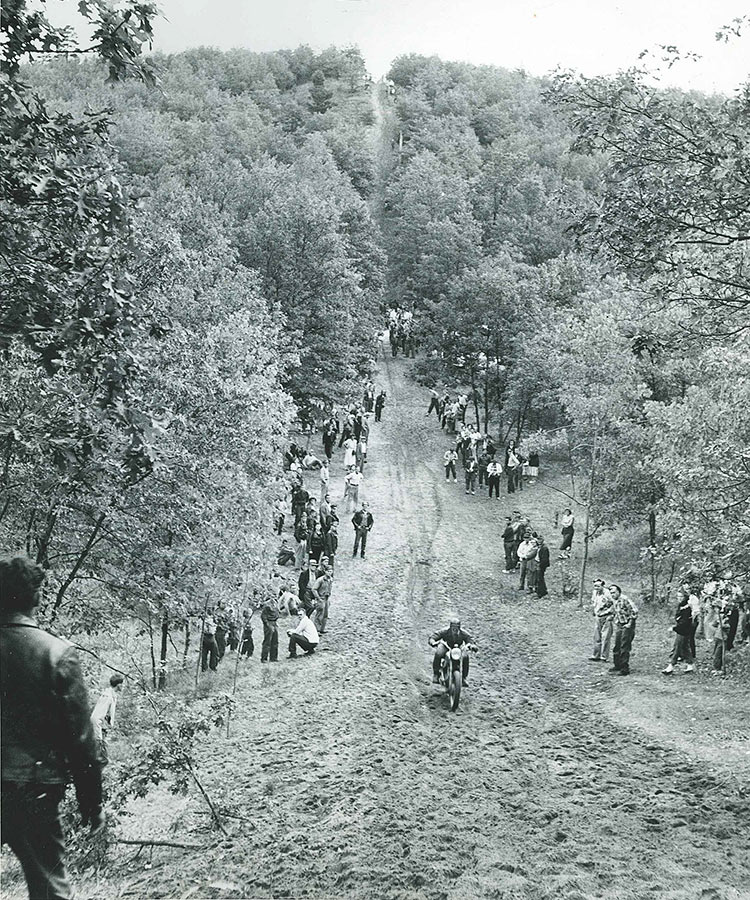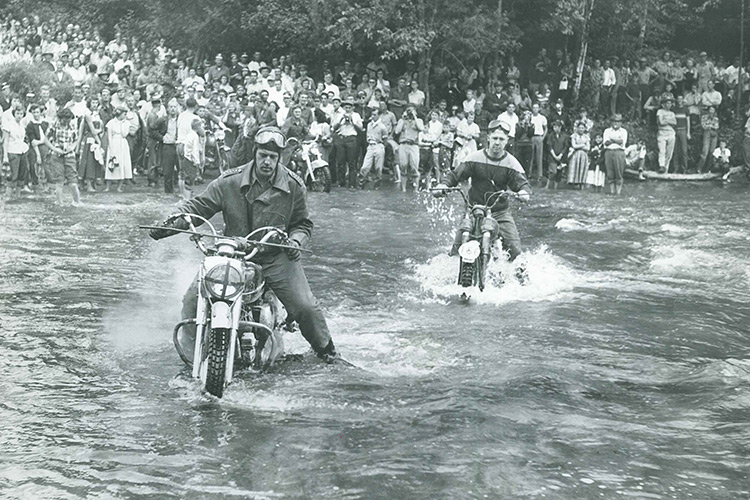Riding Feature
Celebrating 100 Years of History And Service
Lansing Motorcycle Club Has Evolved With The Times
By Heather Wilson
Thirty-six thousand five-hundred days. One hundred years. Ten decades. A century. Keeping an organization operating continuously for such a lengthy period of time is a significant achievement.
Known for its historic competitions, including the world famous Jack Pine Enduro, the Lansing Motorcycle Club truly has encompassed the AMA mission to promote the motorcycle lifestyle and protect the future of motorcycling.
A Rich History
The Michigan club was founded in 1920 by Oscar Lenz, a bicycle shop owner turned Harley-Davidson dealer.
In 1923, the club chartered with the Motorcycle & Allied Trades Association, the AMA’s predecessor. Today, the Lansing Motorcycle Club is among the longest-lived chartered AMA clubs.
Doreen Abfalter, 87, of Grand Ledge, Mich., joined the Lansing Motorcycle Club in 1955. Members consider her the club historian, because she has collected so many documents and memorabilia.
Abfalter said that, in the early days of the club, groups of 30 to 40 motorcyclists from nearby towns would get together for Gypsy Tours, rides organized around a hillclimb or field meet. Club meetings were usually held in members’ homes.
Predated by the “Touring of the Pines,” a three-day, 800-mile event organized by Lenz in 1916, the inaugural Jack Pine Run was held in 1923. Also dubbed the “Cowbell Classic,” the Jack Pine Run is the oldest AMA-sanctioned enduro.
Lenz won the Jack Pine six times, earning induction into the AMA Motorcycle Hall of Fame in 1998.
Other future Hall of Famers who claimed Jack Pine victories include Bill Baird, Joe Gee, John Penton, Earl Robinson and Leroy Winters.
Abfalter said the cowbell nickname was coined when one of the men laying out the Jack Pine Run removed a bell from a cow in a field through which the course would pass.
“Oscar used it as a revolving trophy,” Abfalter said. “The Grand Champion of Jack Pine gets his or her name and date on the trophy.”
Initially, the race distance was 500 miles, stretched over two days during Labor Day weekend.
There was no Jack Pine Run during World War II, 1942-45.
Abfalter’s husband, David, helped design the course with Lenz during the club’s first decade.

▲ James Boxer reaches the bottom of a descent at the 1953 Jack Pine along Skyline Drive.
Photo from the AMA Archives
“They laid it out in a sidecar over two and a half weeks,” Abfalter said. “They built relationships with all of the farmers, townspeople and police departments.”
Abfalter and her husband helped for many years by operating checks and scoring after the event.
“Night control was in West Branch, Mich.,” she said. “Townspeople opened their homes for the racers to sleep, and churches put on dinner and breakfast. Families befriended these motorcyclists.”
Individuals from more than 20 different states competed in the event, which was renamed the Jack Pine Enduro in 1959.
In 1966, tragedy struck.
“Before we got to West Branch, a group of Hells Angels from Detroit terrorized that town,” Abfalter said. “Property damage and theft. Of course, this was before cell phones, and we had no clue this had happened until we got there.”
After the event, townspeople met with Lenz, Abfalter’s husband and Harold Farnum. They decided not to schedule an event for 1967.
That same year, 1966, the club won AMA Club of the Year.
Until 1971, the Jack Pine Run included sidecars, and the champion of that class received a Little Brown Jug rotating trophy.
The event grew, ultimately attracting nearly 600 riders.
Today, it averages between 200 and 300, unless it is a national enduro, which usually brings twice as many entries.
“Over the years,” Abfalter said, “the Jack Pine dropped in mileage, then went from two days to one day.”
This year would have marked the 95th running of the Jack Pine, but it was canceled due to the coronavirus pandemic. (In the past, to make up for wartime cancelations, the club sometimes staged two events in a single year.)
Changing With The Times
In the 1970s, the club was also hosting a single-day enduro in mid-May, called the Knotty Pine.
The club wanted to promote motorcycling to a broader audience. So, in the late 1970s, the Pine Cone Enduro was created to better include wives, sons and daughters, allowing them to ride easier terrain than presented by the Jack Pine Enduro. It was operated the same weekend as the Knotty Pine.
The Pine Cone Enduro spawned the family enduro series.
Today, it draws about 300 entries.
“What I emphasize is that we still utilize a timekeeping format [for the family enduros],” said club member Mike Maurer. “It keeps it from being a wheel-to-wheel competition.”
Abfalter described how events have evolved to better suit the desires of racers.
“You have to adapt to what the riders of today want,” said Abfalter, referring to the difference in timekeeping and restart-format enduros. “The Pine Cone Enduro was started to promote the sport to younger generations, so that it wouldn’t die.”

▲ Before a huge crowd of spectators, competitors navigate a Rifle River crossing during the 1953 Jack Pine event.
Photo from the AMA Archives
It’s a family affair for Abfalter and many other multigenerational riding families in the club. Four generations of Abfalters, a total of 28 family members, have assisted with and ridden in Lansing Motorcycle Club events.
“Many of the families grew up at the club grounds, much like I did,” Maurer said.
The Hunt family also has long ties to the club. When the club won the AMA award in 1966, Ken Hunt was president.
In 2018, the club once again received the AMA Club of the Year award, this time with Jeff Hunt, Ken’s son, serving as president. Jeff’s brother, Jim, and his daughter also are involved.
“One hundred years wasn’t exactly easy,” Jim Hunt said. “But we kept doing it. [Over the years], we wanted to start doing more with other clubs and get more events going for the [AMA] district.”
Finding land for the events eventually became a challenge.
“We had to come up with our own way, because we didn’t have private property,” Jeff Hunt said. “We basically invented a deal with the [state] Department of Natural Resources, where we used the land two years before they timber it. It recycles itself, and we always get new trail within a two-year period.”
Maurer said the club may be the only group of its kind in the Great Lakes area that still uses public land.
Today, the club has about 70 members and owns about 65 acres in Moorestown, Mich., where the clubhouse sits and where members camp with their families.
“The club often will do fun events, like potlucks and kayaking,” Abfalter said.
Giving Back To The Community
Club members participate in Adopt-A-Highway and Adopt-A-Forest programs, maintain 175 miles of trail for the DNR and maintain a historical park in Stratford Village, Mich.
For 10 years, the club also planted trees with the DNR. And the organization is a member of the chambers of commerce in four towns.
“What our club is really about is family, community service and promoting the sport,” Abfalter said.




